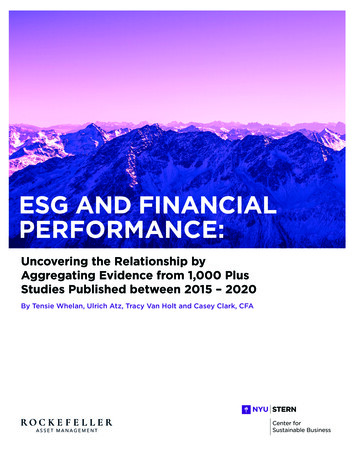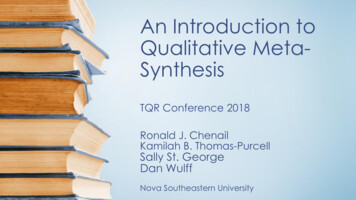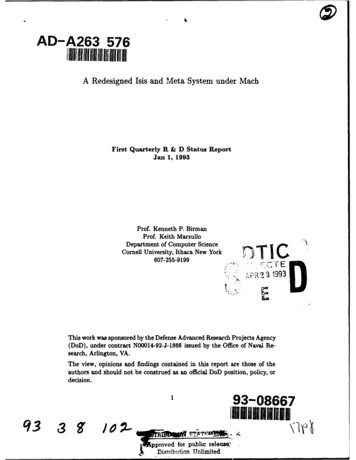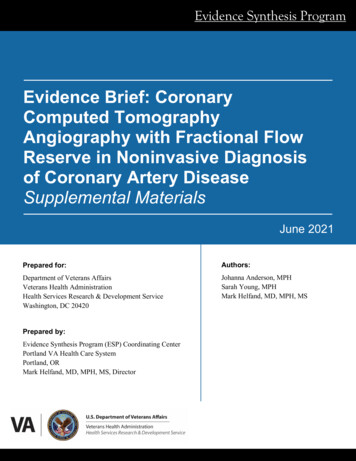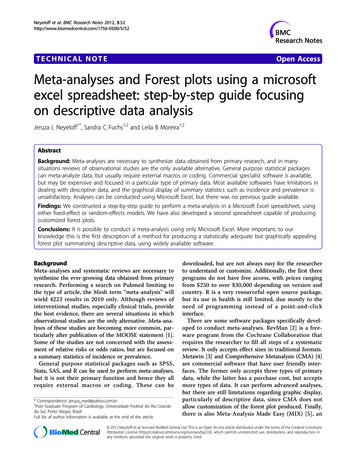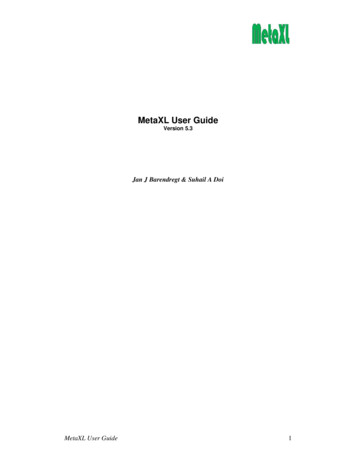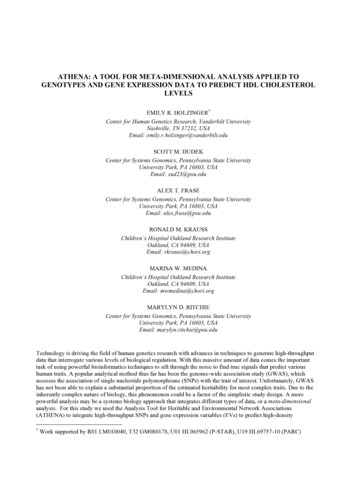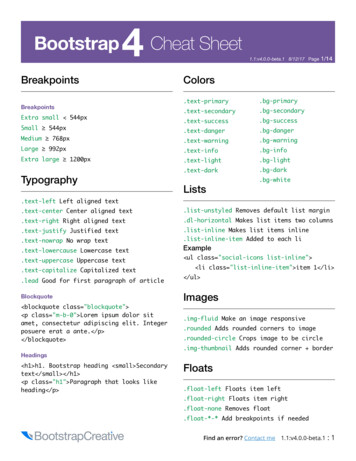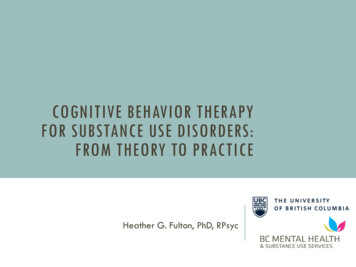
Transcription
SAE./No.200/January 2022/October 2021A LITERATURE REVIEW AND META-ANALYSISOF THE EFFECTS OF LOCKDOWNS ONCOVID-19 MORTALITYAmbika KandasamyJonas Herby, Lars RTALITYJonung, and Steve H. Hanke
A Literature Review and Meta-Analysis of theEffects of Lockdowns on COVID-19 MortalityBy Jonas Herby, Lars Jonung, and Steve H. HankeAbout the SeriesThe Studies in Applied Economics series is under the general direction of Prof. Steve H. Hanke,Founder and Co-Director of The Johns Hopkins Institute for Applied Economics, Global Health,and the Study of Business Enterprise (hanke@jhu.edu). The views expressed in each workingpaper are those of the authors and not necessarily those of the institutions that the authors areaffiliated with.About the AuthorsJonas Herby (herby@cepos.dk) is special advisor at Center for Political Studies in Copenhagen,Denmark. His research focuses on law and economics. He holds a master’s degree in economicsfrom University of Copenhagen.Lars Jonung (lars.jonung@nek.lu.se) is professor emeritus in economics at Lund University,Sweden. He served as chairperson of the Swedish Fiscal Policy Council 2012-13, as researchadvisor at the European Commission 2000-2010, and as chief economic adviser to Prime MinisterCarl Bildt in 1992-94. He holds a PhD in Economics from the University of California, Los Angeles.Steve H. Hanke is a Professor of Applied Economics and Founder & Co-Director of The JohnsHopkins Institute for Applied Economics, Global Health, and the Study of Business Enterprise. Heis a Senior Fellow and Director of the Troubled Currencies Project at the Cato Institute, acontributor at National Review, a well-known currency reformer, and a currency and commoditytrader. Prof. Hanke served on President Reagan’s Council of Economic Advisers, has been anadviser to five foreign heads of state and five foreign cabinet ministers, and held a cabinet-levelrank in both Lithuania and Montenegro. He has been awarded seven honorary doctorate degreesand is an Honorary Professor at four foreign institutions. He was President of Toronto TrustArgentina in Buenos Aires in 1995, when it was the world’s best-performing mutual fund.Currently, he serves as Chairman of the Supervisory Board of Advanced Metallurgical Group N.V.in Amsterdam. In 1998, he was named one of the twenty-five most influential people in the worldby World Trade Magazine. In 2020, Prof. Hanke was named a Knight of the Order of the Flag.1
AbstractThis systematic review and meta-analysis are designed to determine whether there is empiricalevidence to support the belief that “lockdowns” reduce COVID-19 mortality. Lockdowns aredefined as the imposition of at least one compulsory, non-pharmaceutical intervention (NPI).NPIs are any government mandate that directly restrict peoples’ possibilities, such as policies thatlimit internal movement, close schools and businesses, and ban international travel. This studyemployed a systematic search and screening procedure in which 18,590 studies are identifiedthat could potentially address the belief posed. After three levels of screening, 34 studiesultimately qualified. Of those 34 eligible studies, 24 qualified for inclusion in the meta-analysis.They were separated into three groups: lockdown stringency index studies, shelter-in-placeorder (SIPO) studies, and specific NPI studies. An analysis of each of these three groups supportthe conclusion that lockdowns have had little to no effect on COVID-19 mortality. Morespecifically, stringency index studies find that lockdowns in Europe and the United States onlyreduced COVID-19 mortality by 0.2% on average. SIPOs were also ineffective, only reducingCOVID-19 mortality by 2.9% on average. Specific NPI studies also find no broad-based evidenceof noticeable effects on COVID-19 mortality.While this meta-analysis concludes that lockdowns have had little to no public health effects,they have imposed enormous economic and social costs where they have been adopted. Inconsequence, lockdown policies are ill-founded and should be rejected as a pandemic policyinstrument.AcknowledgementsThe authors thank Line Andersen, Troels Sabroe Ebbesen, Nicholas Hanlon, and Anders LundMortensen for their research assistance.The authors also with to thank Douglas Allen, Fredrik N. G. Andersson, Jonas Björk, ChristianBjørnskov, Joakim Book, Gunnar Brådvik, Kristoffer Torbjørn Bæk, Ulf Gerdtham, Daniel B. Klein,Fredrik Charpentier Ljungqvist, Christian Heebøl-Nielsen, Martin Paldam, Jonas Ranstam,Spencer Ryan, John Strezewski, Roger Svensson, Ulf Persson, Anders Waldenström, and JoakimWesterlund for their comments.Key Words: COVID-19, lockdown, non-pharmaceutical interventions, mortality, systematicreview, meta-analysisJEL Classification: I18; I38; D192
1IntroductionThe global policy reaction to the COVID-19 pandemic is evident. Compulsory nonpharmaceutical interventions (NPIs), commonly known as “lockdowns” – policies that restrictinternal movement, close schools and businesses, and ban international travel – have beenmandated in one form or another in almost every country.The first NPIs were implemented in China. From there, the pandemic and NPIs spread first toItaly and later to virtually all other countries, see Figure 1. Of the 186 countries covered by theOxford COVID-19 Government Response Tracker (OxCGRT), only Comoros, an island countryin the Indian Ocean, did not impose at least one NPI before the end of March 2020.Figure 1: Share of countries with OxCGRT stringency index above thresholds, January June 2020Comment: The figure shows the share of countries, where the OxCGRT stringency index on a given date surpassed index 65, 70and 75 respectively. Only countries with more than one million citizens are included (153 countries in total). The OxCGRTstringency index records the strictness of NPI policies that restrict people’s behavior. It is calculated using all ordinalcontainment and closure policy indicators (i.e., the degree of school and business closures, etc.), plus an indicator recordingpublic information campaigns.Source: Our World in Data.Early epidemiological studies predicted large effects of NPIs. An often cited model simulationstudy by researchers at the Imperial College London (Ferguson et al. (2020)) predicted that a3
suppression strategy based on a lockdown would reduce COVID-19 mortality by up to 98%.1These predictions were questioned by many scholars. Our early interest in the subject wasspurred by two studies. First, Atkeson et al. (2020) showed that “across all countries and U.S.states that we study, the growth rates of daily deaths from COVID-19 fell from a wide range ofinitially high levels to levels close to zero within 20-30 days after each region experienced 25cumulative deaths.” Second, Sebhatu et al. (2020) showed that “government policies are stronglydriven by the policies initiated in other countries,” and less by the specific COVID-19-situationof the country.A third factor that motivated our research was the fact that there was no clear negativecorrelation between the degree of lockdown and fatalities in the spring of 2020 (see Figure 2).Given the large effects predicted by simulation studies such as Ferguson et al. (2020), we wouldhave expected to at least observe a simple negative correlation between COVID-19 mortality andthe degree to which lockdowns were imposed. 2Figure 2: Correlation between stringency index and COVID-19 mortality in Europeancountries and U.S. states during the first wave in 2020Source: Our World in Data1With R0 2.4 and trigger on 60, the number of COVID-19-deaths in Great Britain could be reduced to 8,700deaths from 510,000 deaths (-98%) with a policy consisting of case isolation home quarantine socialdistancing school/university closure, cf. Table 4 in Ferguson et al. (2020). R0 (the basic reproduction rate) is theexpected number of cases directly generated by one case in a population where all individuals are susceptible toinfection.2In addition, the interest in this issue was sparked by the work Jonung did on the expected economic effects of theSARS pandemic in Europe in 2006 (Jonung and Röger, 2006). In this model-based study calibrated from Spanishflu data, Jonung and Röger concluded that the economic effects of a severe pandemic would be rather limited—asharp contrast to the huge economic effects associated with lockdowns during the COVID-19 pandemic.4
Today, it remains an open question as to whether lockdowns have had a large, significant effecton COVID-19 mortality. We address this question by evaluating the current academic literatureon the relationship between lockdowns and COVID-19 mortality rates.3 We use “NPI” todescribe any government mandate which directly restrict peoples’ possibilities. Our definitiondoes not include governmental recommendations, governmental information campaigns, accessto mass testing, voluntary social distancing, etc., but do include mandated interventions such asclosing schools or businesses, mandated face masks etc. We define lockdown as any policyconsisting of at least one NPI as described above. 4Compared to other reviews such as Herby (2021) and Allen (2021), the main difference in thismeta-analysis is that we carry out a systematic and comprehensive search strategy to identify allpapers potentially relevant to answer the question we pose. We identify 34 eligible empiricalstudies that estimate the effect of mandatory lockdowns on COVID-19 mortality using acounterfactual difference-in-difference approach. We present our results in such a way that theycan be systematically assessed, replicated, and used to derive overall meta-conclusions.52Identification process: Search strategy and eligibility criteriaFigure 3 shows an overview of our identification process using a flow diagram designedaccording to PRISMA guidelines (Moher et al. (2009). Of 18,590 studies identified during ourdatabase searches, 1,048 remained after a title-based screening. Then, 931 studies were excluded,because they either did not measure the effect of lockdowns on mortality or did not use anempirical approach. This left 117 studies that were read and inspected. After a more thoroughassessment, 83 of the 117 were excluded, leaving 34 studies eligible for our meta-analysis. Atable with all 83 studies excluded in the final step can be found in Appendix B, Table 8.We use “mortality” and “mortality rates” interchangeably to mean COVID-19 deaths per population.For example, we will say that Country A introduced the non-pharmaceutical interventions school closures andshelter-in-place-orders as part of the country’s lockdown.5An interesting question is, “What damage lockdowns do to the economy, personal freedom and rights, and publichealth in general?” Although this question is important, it requires a full cost-benefit study, which is beyond thescope of this study.345
Figure 3: PRISMA flow diagram for the selection of studies.Below we present our search strategy and eligibility criteria, which follow the PRISMAguidelines and are specified in detail in our protocol Herby et al. (2021).2.1Search strategyThe studies we reviewed were identified by scanning Google Scholar and SCOPUS for Englishlanguage studies. We used a wide range of search terms which are combinations of three searchstrings: a disease search string (“covid,” “corona,” “coronavirus,” “sars-cov-2”), a government6
response search string6, and a methodology search string7. We identified papers based on 1,360search terms. We also required mentions of “deaths,” “death,” and/or “mortality.” The searchterms were continuously updated (by adding relevant terms) to fit this criterion.8We also included all papers published in Covid Economics. Our search was performed betweenJuly 1 and July 5, 2021 and resulted in 18,590 unique studies.9 All studies identified usingSCOPUS and Covid Economics were also found using Google Scholar. This made uscomfortable that including other sources such as VOXeu and SSRN would not change the result.Indeed, many papers found using Google Scholar were from these sources.All 18,590 studies were first screened based on the title. Studies clearly not related to ourresearch question were deemed irrelevant.10After screening based on the title, 1,048 papers remained. These papers were manually screenedby answering two questions:1. Does the study measure the effect of lockdowns on mortality?2. Does the study use an empirical ex post difference-in-difference approach (see eligibilitycriteria below)?Studies to which we could not answer “yes” to both questions were excluded. When in doubt, wemade the assessment based on reading the full paper, and in some cases, we consulted withcolleagues.11After the manual screening, 117 studies were retrieved for a full, detailed review. These studieswere carefully examined, and metadata and empirical results were stored in an ExcelThe government response search string used was: “non-pharmaceutical,” “nonpharmaceutical,” ”NPI,” ”NPIs,””lockdown,” “social distancing orders,” “statewide interventions,” “distancing interventions,” “circuit breaker,”“containment measures,” “contact restrictions,” “social distancing measures,” “public health policies,” “mobilityrestrictions,” “covid-19 policies,” “corona policies,” “policy measures.”7The methodology search string used was: (“fixed effects,” “panel data,” “difference-in-difference,” “diff-in-diff,”“synthetic control,” “counterfactual” , “counter factual,” “cross country,” “cross state,” “cross county,” “crossregion,” “cross regional,” “cross municipality,” “country level,” “state level,” “county level,” “region level,”“regional level,” “municipality level,” “event study.”8If a potentially relevant paper from one of the 13 reviews (see eligibility criteria) did not show up in our search, weadded relevant words to our search strings and ran the search again. The 13 reviews were: Allen (2021); Brodeuret al. (2021); Gupta et al. (2020); Herby (2021); Johanna et al. (2020); Nussbaumer-Streit et al. (2020); Patel et al.(2020); Perra (2020); Poeschl and Larsen (2021); Pozo-Martin et al. (2020); Rezapour et al. (2021); Robinson(2021); Zhang et al. (2021).9SCOPUS was continuously monitored between July 5th and publication using a search agent. Although the searchagent returned several hits during this period, only one of them, An et al. (2021), was eligible according to oureligibility criteria. The study is not included in our review, but the conclusions are in line with our conclusions, asAn et al. (2021) conclude that “The analysis shows that the mask mandate is consistently associated with lowerinfection rates in the short term, and its early adoption boosts the long-term efficacy. By contrast, the other fivepolicy instruments— domestic lockdowns, international travel bans, mass gathering bans, and restaurant andschool closures—show weaker efficacy.”10This included studies with titles such as “COVID-19 outbreak and air pollution in Iran: A panel VAR analysis”and “Dynamic Structural Impact of the COVID-19 Outbreak on the Stock Market and the Exchange Rate: ACross-country Analysis Among BRICS Nations.”11Professor Christian Bjørnskov of University of Aarhus was particularly helpful in this process.67
spreadsheet. All studies were assessed by at least two researchers. During this process, another64 papers were excluded because they did not meet our eligibility criteria. Furthermore, ninestudies with too little jurisdictional variance ( 10 observations) were excluded,12 and 10synthetic control studies were excluded.13 A table with all 83 studies excluded in the final stepcan be found in Appendix B, Table 8. Below we explain why these studies are excluded.2.2Eligibility criteriaFocus on mortality and lockdownsWe only include studies that attempt to establish a relationship (or lack thereof) betweenlockdown policies and COVID-19 mortality or excess mortality. We exclude studies that usecases, hospitalizations, or other measures.14Counterfactual difference-in-difference approachWe distinguish between two methods used to establish a relationship (or lack thereof) betweenmortality rates and lockdown policies. The first uses registered cross-sectional mortality data.These are ex post studies. The second method uses simulated data on mortality and infectionrates.15 These are ex ante studies.We include all studies using a counterfactual difference-in-difference approach from the formergroup but disregard all ex ante studies, as the results from these studies are determined by modelassumptions and calibrations.Our limitation to studies using a “counterfactual difference-in-difference approach” means thatwe exclude all studies where the counterfactual is based on forecasting (such as a SIR-model)rather than derived from a difference-in-difference approach. This excludes studies likeDuchemin et al. (2020) and Matzinger and Skinner (2020). We also exclude all studies based oninterrupted time series designs that simply compare the situation before and after lockdown, as12The excluded studies with too few observations were: Alemán et al. (2020), Berardi et al. (2020), Conyon et al.(2020a), Coccia (2021), Gordon et al. (2020), Juranek and Zoutman (2021), Kapoor and Ravi (2020), Umer andKhan (2020), and Wu and Wu (2020).13The excluded synthetic control studies were: Conyon and Thomsen (2021), Dave et al. (2020), Ghosh et al.(2020), Born et al. (2021), Reinbold (2021), Cho (2020), Friedson et al. (2021), Neidhöfer and Neidhöfer (2020),Cerqueti et al. (2021), and Mader and Rüttenauer (2021).14Analyses based on cases may pose major problems, as testing strategies for COVID-19 infections varyenormously across countries (and even over time within a given country). In consequence, cross-countrycomparisons of cases are, at best, problematic. Although these problems exist with death tolls as well, they are farmore limited. Also, while cases and death tolls are correlated, there may be adverse effects of lockdowns that arenot captured by the number of cases. For example, an infected person who is isolated at home with family under aSIPO may infect family members with a higher viral load causing more severe illness. So even if a SIPO reducesthe number of cases, it may theoretically increase the number of COVID-19-deaths. Adverse effects like this mayexplain why studies like Chernozhukov et al. (2021) finds that SIPO reduces the number of cases but have nosignificant effect on the number of COVID-19-deaths. Finally, mortality is hierarchically the most importantoutcome, cf. GRADEpro (2013)15These simulations are often made in variants of the SIR-model, which can simulate the progress of a pandemic ina population consisting of people in different states (Susceptible, Infectious, or Recovered) with equationsdescribing the process between these states.8
the effect of lockdowns in these studies might contain time-dependent shifts, such as seasonality.This excludes studies like Bakolis et al. (2021) and Siedner et al. (2020).Given our criteria, we exclude the much-cited paper by Flaxman et al. (2020), which claimedthat lockdowns saved three million lives in Europe. Flaxman et al. assume that the pandemicwould follow an epidemiological curve unless countries locked down. However, this assumptionmeans that the only interpretation possible for the empirical results is that lockdowns are the onlything that matters, even if other factors like season, behavior etc. caused the observed change inthe reproduction rate, Rt. Flaxman et al. are aware of this and state that “our parametric form ofRt assumes that changes in Rt are an immediate response to interventions rather than gradualchanges in behavior.” Flaxman et al. illustrate how problematic it is to force data to fit a certainmodel if you want to infer the effect of lockdowns on COVID-19 mortality.16The counterfactual difference-in-difference studies in this review generally exploit variationacross countries, U.S. states, or other geographical jurisdictions to infer the effect of lockdownson COVID-19 fatalities. Preferably, the effect of lockdowns should be tested using randomizedcontrol trials, natural experiments, or the like. However, there are very few studies of this type.17Synthetic control studiesThe synthetic control method is a statistical method used to evaluate the effect of an interventionin comparative case studies. It involves the construction of a synthetic control which functions asthe counter factual and is constructed as an (optimal) weighted combination of a pool of donors.For example, Born et al. (2021) create a synthetic control for Sweden which consists of 30.0%Denmark, 25.3% Finland, 25.8% Netherlands, 15.0% Norway, and 3.9% Sweden. The effect ofthe intervention is derived by comparing the actual developments to those contained in thesynthetic control.We exclude synthetic control studies because of their inherent empirical problems as discussedby Bjørnskov (2021b). He finds that the synthetic control version of Sweden in Born et al. (2021)deviates substantially from “actual Sweden,” when looking at the period before mid-March 2020,when Sweden decided not to lock down. Bjørnskov estimates that actual Sweden experienced16Several scholars have criticized Flaxman et al. (2020), e.g. see Homburg and Kuhbandner (2020), Lewis (2020),and Lemoine (2020).17Kepp and Bjørnskov (2021) is one such study. They use evidence from a quasi-natural experiment in the Danishregion of Northern Jutland. After the discovery of mutations of Sars-CoV-2 in mink – a major Danish export –seven of the 11 municipalities of the region went into extreme lockdown in early November, while the four othermunicipalities retained the moderate restrictions of the remaining country. Their analysis shows that whileinfection levels decreased, they did so before lockdown was in effect, and infection numbers also decreased inneighbor municipalities without mandates. They conclude that efficient infection surveillance and voluntarycompliance make full lockdowns unnecessary, at least in some circumstances. Kepp and Bjørnskov (2021) is notincluded in our review, because they focus on cases and not COVID-19 mortality. Dave et al. (2020) is anothersuch study. They see the Wisconsin Supreme Court abolishment of Wisconsin’s “Safer at Home” order (a SIPO)as a natural experiment and find that “the repeal of the state SIPO impacted social distancing, COVID-19 cases, orCOVID-19-related mortality during the fortnight following enactment.” Dave et al. (2020) is not included in ourreview, because they use a synthetic control method.9
approximately 500 fewer deaths the first 11 weeks of 2020 and 4,500 fewer deaths in 2019compared to synthetic Sweden.This problem is inherent in all synthetic control studies of COVID-19, Bjørnskov argues,because the synthetic control should be fitted based on a long period of time before theintervention or the event one is studying the consequences of – i.e., the lockdown Abadie (2021).However, this is not possible for the coronavirus pandemic, as there clearly is no long periodwith coronavirus before the lockdown. Hence, the synthetic control study approach is by designnot appropriate for studying the effect of lockdowns.Jurisdictional variance - few observationsWe exclude all interrupted time series studies which simply compare mortality rates before andafter lockdowns. Simply comparing data from before and after the imposition of lockdownscould be the result of time-dependent variations, such as seasonal effects. For the same reason,we also exclude studies with little jurisdictional variance.18 For example, we exclude Conyon etal. (2020b) who “exploit policy variation between Denmark and Norway on the one hand andSweden on the other” and, thus, only have one jurisdictional area in the control group. Althoughthis is a difference-in-difference approach, there is a non-negligible risk that differences arecaused by much more than just differences in lockdowns. Another example is Wu and Wu(2020), who use all U.S. states, but pool groups of states so they end with basically threeobservations. None of the excluded studies cover more than 10 jurisdictional areas.19 One studyis a special case of the jurisdictional variance criteria (Auger et al. (2020). Those researchersanalyze the effect of school closures in U.S. states and find that those closures reduce mortalityby 35%. However, all 50 states closed schools between March 13, 2020, and March 23, 2020,which means that all difference-in-difference is based on maximum 10 days. Given the long lagbetween infection and death, there is a risk that Auger et al.’s approach is an interrupted timeseries analysis where they compare United States before and after school closures, rather than atrue difference-in-difference approach. However, we choose to include this study, as it is eligibleunder our protocol Herby et al. (2021).Publication status and dateWe include all ex post studies regardless of publication status and date. That is, we cover bothworking papers and papers published in journals. We include the early papers because theknowledge of the COVID-19-pandemic grew rapidly in the beginning, making later papers ableto stand on the shoulders of previous work. Also, in the early days of COVID-19, speed wasA jurisdictional area can be countries, U.S. states, or counties. With "jurisdictional variance” we refer to variationin mandates across jurisdictional areas.19All studies excluded on this criterion are listed in footnote 12.1810
crucial which may have affected the quality of the papers. Including them makes it possible tocompare the results of early studies to studies carried out at a later stage.20The role of optimal timingWe exclude papers which analyze the effect of early lockdowns in contrast to later lockdowns.There’s no doubt that being prepared for a pandemic and knowing when it arrives at yourdoorstep is vital. However, at least two problems arise with respect to evaluating the effect ofwell-timed lockdowns.First, when COVID-19 hit Europe and the United States, it was virtually impossible to determinethe right timing. The World Health Organization declared the outbreak a pandemic on March 11,2020, but at that date, Italy had already registered 13.7 COVID-19 deaths per million. On March29, 2020, 18 days after the WHO declared the outbreak a pandemic and the earliest a lockdownresponse to the WHO’s announcement could potentially have an effect, the mortality rate in Italywas a staggering 178 COVID-19 deaths per million with an additional 13 per million dying eachday.21Secondly, it is extremely difficult to differentiate between the effect of public awareness and theeffect of lockdowns when looking at timing because people and politicians are likely to react tothe same information. As Figure 4 illustrates, all European countries and U.S. states that were hithard and early by COVID-19 experienced high mortality rates, whereas all countries hitrelatively late experienced low mortality rates. Björk et al. (2021) illustrate the difficulties inanalyzing the effect of timing. They find that a 10-stringency-points-stricter lockdown wouldreduce COVID-19 mortality by a total of 200 deaths per million22 if done in week 11, 2020, butwould only have approximately 1/3 of the effect if implemented one week earlier or later and noeffect if implemented three weeks earlier or later. One interpretation of this result is thatlockdowns do not work if people either find them unnecessary and fail to obey the mandates or ifpeople voluntarily lock themselves down. This is the argument Allen (2021) uses for theineffectiveness of the lockdowns he identifies. If this interpretation is true, what Björk et al.(2021) find is that information and signaling is far more important than the strictness of thelockdown. There may be other interpretations, but the point is that studies focusing on timingcannot differentiate between these interpretations. However, if lockdowns have a notable effect,we should see this effect regardless of the timing, and we should identify this effect morecorrectly by excluding studies that exclusively analyze timing.20We also intended to exclude studies which were primarily based on data from 2021 (as these studies would beheavily affected by vaccines) and studies that did not cover at least one EU-country, the United States, one U.S.U.S. state or Latin America, and where at least one country/state was not an island. However, we did not find anysuch studies.21There’s approximately a two-to-four-week gap between infection and deaths. See footnote 29.22They estimate that 10-point higher stringency will reduce excess mortality by 20 “per week and million” in the 10weeks from week 14 to week 23.11
Figure 4: Taken by surprise. The importance of having time to prepareUnited States9001,8008001,6001st wave deaths pr. million1st wave deaths pr. 3-Jun-2014-Apr-2019-May-2023-Jun-20Date to reach 20 COVID-19-deaths per millionDate to reach 20 COVID-19-deaths per millionComment: The figure shows the relationship between early pandemic strength and total 1st wave of COVID-19 death toll. On theX-axis is “Days to reach 20 COVID-19-deaths per million (measured from February 15, 2020).” The Y-axis shows mortality(deaths per million) by June 30, 2020.Source: Reported COVID-19 deaths and OxCGRT stringency for European countries and U.S. states with more than one millioncitizens. Data from Our World in Data.We are aware of one meta-analysis by Stephens et al. (2020), which looks into the importance oftiming. The authors find 22 studies that look at policy and timing with respect to mortality rates,however, only four were multi-country, multi-policy studies, which could possibly account forthe problems described above. Stephens et al. conclude that “the timing of policy interventionsacross countries relative to t
Denmark. His research focuses on law and economics. He holds a master's degree in economics from University of Copenhagen. Lars Jonung (lars.jonung@nek.lu.se) is professor emeritus in economics at Lund University, Sweden. He served as chairperson of the Swedish Fiscal Policy Council 2012-13, as research

